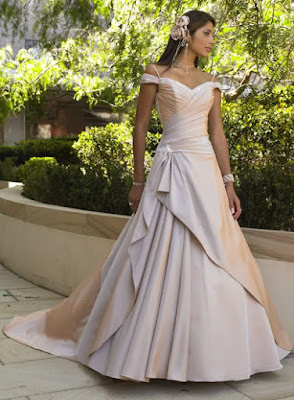The majority of brides in this country still prefer traditional wedding dresses over some of the less conventional alternatives. So what does a traditional wedding dress look like exactly? For the most part, all traditional dresses are long and white or in a shade that is closely related to white such as ecru and eggshell. Beyond that, there are various silhouettes and necklines that will make some dresses look more traditional than others.
Let's start by examining the length of a dress. Traditional wedding dresses are typically floor length, and they can either have a train or not. Any dress that is tea length or shorter does not qualify as a traditional dress. The white wedding dress has been a staple for decades, when you picture a bride walking down the aisle, she will always be in white. For this reason if the bride wears a colorful dress, it will be considered anything but traditional.
There are five common silhouettes that most wedding gowns fall under. They include the A-line dress, which has a tight bodice and flows out toward the ground. The ball gown which also has a tight bodice but a very full skirt. The sheath dress, which is shaped kind of like a line going straight down. The mermaid, which hugs the curves until about the knee and then flows outward. The empire dress, which has a higher than usual waistline that flows out. Of all these silhouettes, traditional wedding dresses are most commonly A-line or ball gown.
Next we move on to the neckline. Most necklines can be considered traditional, from boat neck to strapless. These necklines have been used for wedding gowns for decades. Other common necklines include the V-neck or plunge neckline, the scoop, the halter, and the sweetheart neckline. The only one that appears to be a little less traditional and a little more modern is the one shoulder or asymmetrical neckline.
Besides the length, color and shape, traditional wedding dresses can also be distinguished by some other factors. Fabric for instance may play a big part. There are a handful of fabrics that are always associated with wedding dresses, they include tulle, organza, charmeuse, silk, chiffon and satin. If any fabric that is a far cry from one of these is used to make a wedding dress, that dress cannot be considered traditional. Take the fabric velvet, it's been used before, but seems only appropriate for weddings with a medieval theme and not a traditional wedding.
The details of the wedding dress is just as important as all of the other factors. Ruffles for instance, are a fairly new trend that you won't see on more traditional dresses. Beading and other embellishments may be common even for something more traditional, however any kind of embellishment that is over the top is not. Feathers are a great example, there are dresses with the entire bottom covered in feathers. That kind of unique style is definitely not something that would be worn by a traditional bride.









No comments:
Post a Comment